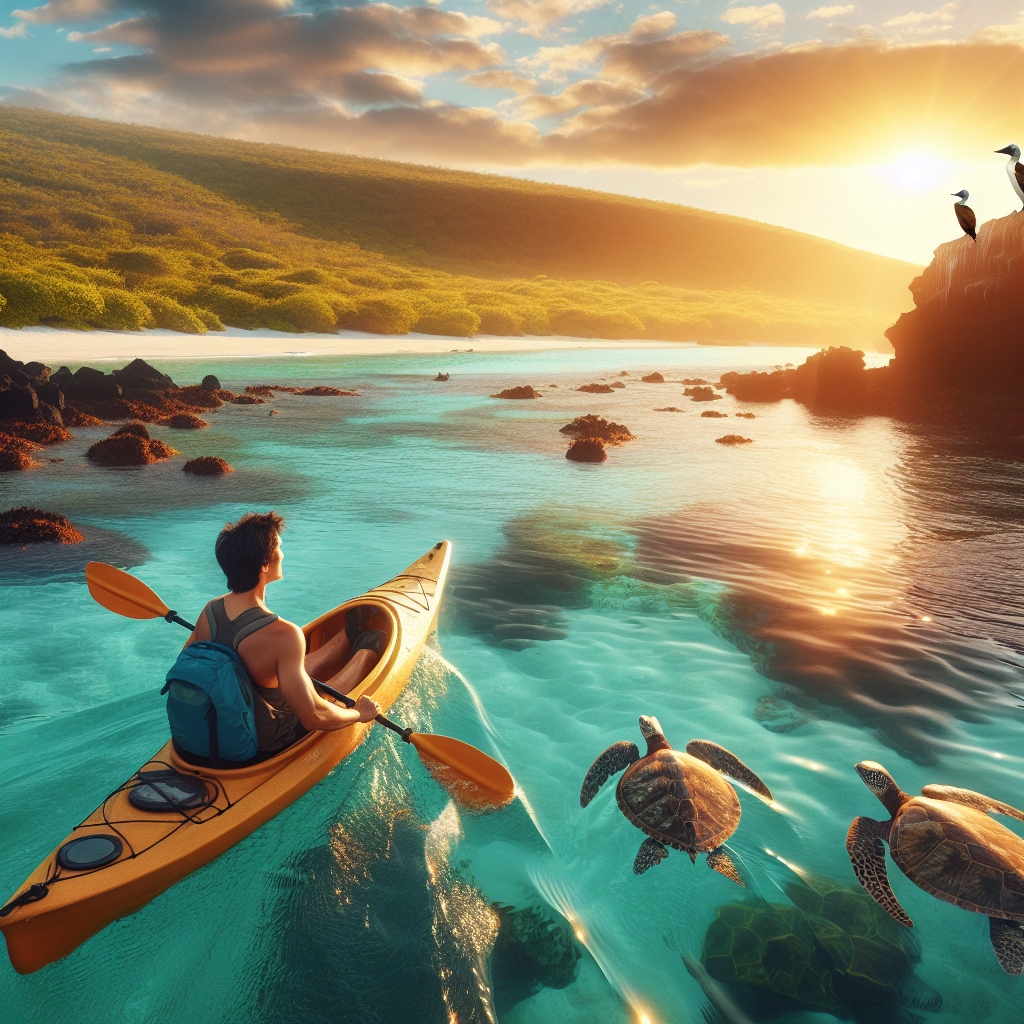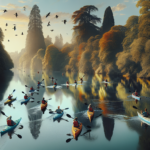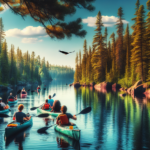Kayaking in Galápagos Islands, Ecuador
Introduction to Kayaking
Kayaking is an exhilarating outdoor activity that has gained immense popularity worldwide. It offers a unique way to explore water bodies, from serene lakes to roaring rivers and vast oceans. The thrill of paddling through water, navigating through waves, and experiencing nature up close makes kayaking a favorite among adventure enthusiasts. Whether you’re a seasoned kayaker or a beginner, the sport offers something for everyone.
In this article, we will spotlight the unique features of kayaking in the Galápagos Islands, Ecuador. This destination is renowned for its stunning landscapes, rich biodiversity, and pristine waters, making it a fantastic spot for kayaking enthusiasts. We’ll delve into the specifics of what makes the Galápagos Islands a must-visit for anyone looking to experience kayaking in a truly unique setting.
Kayaking in the Galápagos Islands offers an unparalleled experience. The archipelago’s unique geography, diverse wildlife, and crystal-clear waters provide a kayaking adventure like no other. From paddling alongside sea lions to exploring hidden coves and beaches, the Galápagos Islands promise an unforgettable journey for kayakers.
In the following sections, we’ll explore the various aspects of kayaking in the Galápagos Islands, including the best spots, conditions, safety guidelines, and more. Whether you’re planning your first trip or looking for new adventures, this guide will provide all the information you need to make the most of your kayaking experience in the Galápagos Islands.
Overview of Kayaking in Galápagos Islands, Ecuador
The Galápagos Islands, located off the coast of Ecuador, are a UNESCO World Heritage site known for their unique wildlife and stunning natural beauty. The archipelago consists of 13 major islands and numerous smaller islets, each offering its own unique landscapes and ecosystems. The islands’ volcanic origins have created a diverse range of habitats, from lush highlands to arid lowlands and pristine beaches.
The climate in the Galápagos Islands is generally mild, with two main seasons: the warm, wet season from December to May and the cool, dry season from June to November. The warm season is characterized by higher temperatures and occasional rain showers, while the cool season brings cooler temperatures and stronger winds. Both seasons offer excellent conditions for kayaking, with calm waters and clear skies.
Visitors can access the Galápagos Islands by flying into one of the two main airports, located on Baltra Island and San Cristóbal Island. From there, various transportation options, including boats and ferries, are available to reach different islands and kayaking spots. The best time to visit for kayaking depends on personal preferences, but many kayakers prefer the warm season for its calmer waters and pleasant weather.
Historically, the Galápagos Islands have been a hub for scientific research and exploration, with Charles Darwin’s visit in 1835 being one of the most famous. While kayaking itself may not have deep historical roots in the islands, water-based activities have always been integral to the local culture and tourism industry. Today, kayaking is a popular way to explore the islands’ unique marine environments and get up close with the incredible wildlife.
Kayaking Conditions in Galápagos Islands, Ecuador
The waters surrounding the Galápagos Islands are part of the Pacific Ocean, offering a mix of calm bays and more challenging open-water conditions. The islands’ unique geography creates a variety of kayaking environments, from sheltered coves and mangrove lagoons to rugged coastlines and open sea passages. This diversity allows kayakers of all skill levels to find suitable routes and challenges.
The weather conditions in the Galápagos Islands are generally favorable for kayaking year-round. During the warm season (December to May), water temperatures range from 70°F to 80°F (21°C to 27°C), making it comfortable for paddling and swimming. The cool season (June to November) brings slightly cooler water temperatures, ranging from 65°F to 75°F (18°C to 24°C), and stronger winds, which can create more challenging conditions for kayakers.
Tides and currents are important factors to consider when kayaking in the Galápagos Islands. The islands experience semi-diurnal tides, meaning there are two high tides and two low tides each day. Tidal ranges can vary significantly, affecting water levels and currents in different areas. It’s essential for kayakers to be aware of tide schedules and plan their routes accordingly to avoid strong currents and potential hazards.
Environmental factors such as wind and waves also play a role in kayaking conditions. The cool season tends to have stronger winds, which can create choppier waters and more challenging paddling conditions. However, many sheltered bays and coves offer protection from the wind, providing calm and enjoyable kayaking experiences. It’s always a good idea to check weather forecasts and local conditions before heading out on a kayaking adventure.
Top Spots for Kayaking in Galápagos Islands, Ecuador
One of the top spots for kayaking in the Galápagos Islands is Tortuga Bay on Santa Cruz Island. This stunning beach is known for its white sand and crystal-clear waters, making it a perfect spot for a leisurely paddle. Kayakers can explore the calm waters of the bay, paddle through mangrove forests, and spot a variety of wildlife, including marine iguanas, sea turtles, and colorful fish.
Another popular kayaking destination is Isabela Island, the largest island in the archipelago. Isabela offers diverse kayaking experiences, from exploring the calm waters of Concha de Perla to navigating the rugged coastline of Punta Vicente Roca. Kayakers can encounter playful sea lions, penguins, and even sharks in these waters. The island’s volcanic landscapes and pristine beaches add to the allure of kayaking here.
San Cristóbal Island is also a favorite among kayakers, with its beautiful coastline and abundant marine life. One of the top spots on the island is Kicker Rock, a dramatic rock formation rising out of the sea. Kayakers can paddle around the rock, exploring its underwater caves and tunnels while spotting rays, sharks, and sea turtles. The calm waters and stunning scenery make this a must-visit spot for kayaking enthusiasts.
For those seeking a more remote and adventurous kayaking experience, Floreana Island offers a unique opportunity. The island’s secluded beaches and coves provide a tranquil setting for paddling, with opportunities to see flamingos, rays, and sea lions. The island’s rich history, including its mysterious past and pirate legends, adds an extra layer of intrigue to the kayaking experience.
Safety and Regulations
Safety is paramount when kayaking in the Galápagos Islands. Local regulations require all kayakers to wear life jackets at all times while on the water. It’s also recommended to carry a whistle, a waterproof map, and a first aid kit. Kayakers should be aware of their surroundings and avoid getting too close to wildlife, as this can be dangerous for both the animals and the kayakers.
Before heading out on a kayaking trip, it’s essential to check weather conditions and tide schedules. Strong winds and currents can make kayaking challenging and potentially hazardous. It’s advisable to paddle in groups and inform someone onshore about your planned route and estimated return time. In case of an emergency, having a communication device such as a VHF radio or a mobile phone in a waterproof case can be crucial.
Respecting local regulations and guidelines is vital for preserving the natural beauty and ecological balance of the Galápagos Islands. Kayakers should avoid disturbing wildlife and adhere to designated landing sites to minimize their impact on the environment. It’s also important to follow Leave No Trace principles, such as packing out all trash and avoiding damage to vegetation and coral reefs.
For those new to kayaking or unfamiliar with the area, hiring a local guide can enhance safety and provide valuable insights into the islands’ natural and cultural history. Guided tours often include safety briefings, equipment checks, and expert guidance on navigating the waters. This can be especially beneficial for beginners or those looking to explore more challenging routes.
Amenities and Accommodations
The Galápagos Islands offer a range of amenities to support kayaking adventures. Several rental facilities provide high-quality kayaks, paddles, life jackets, and other necessary gear. These rental shops often have knowledgeable staff who can offer advice on the best spots to kayak and provide safety tips. Additionally, many guided tours are available, offering everything from half-day excursions to multi-day adventures.
Accommodation options in the Galápagos Islands cater to various preferences and budgets. From luxury hotels and eco-lodges to budget-friendly hostels and camping sites, there’s something for everyone. Many accommodations are located near popular kayaking spots, providing easy access to the water. Some lodges and hotels even offer kayaking packages that include guided tours and equipment rentals.
For those looking to combine kayaking with other activities, the Galápagos Islands have plenty to offer. Snorkeling, diving, hiking, and wildlife watching are just a few of the additional recreational activities available. Many tour operators offer multi-activity packages, allowing visitors to experience the best of what the islands have to offer both on land and in the water.
When planning a kayaking trip to the Galápagos Islands, it’s essential to book accommodations and tours in advance, especially during peak travel seasons. This ensures availability and allows for better planning of your kayaking itinerary. Whether you’re looking for a relaxing paddle or an adventurous expedition, the Galápagos Islands provide a perfect backdrop for an unforgettable kayaking experience.
Environmental Considerations
Preserving the natural habitats and wildlife of the Galápagos Islands is of utmost importance. Kayakers should practice eco-friendly kayaking by avoiding contact with wildlife and maintaining a safe distance. It’s crucial to follow designated routes and landing sites to minimize the impact on sensitive ecosystems. Using biodegradable sunscreen and avoiding single-use plastics can also help reduce environmental impact.
Several conservation efforts and local projects are in place to protect the unique biodiversity of the Galápagos Islands. Visitors can support these initiatives by participating in eco-friendly tours and choosing accommodations that prioritize sustainability. Many tour operators and lodges contribute to conservation projects, such as habitat restoration and wildlife monitoring, allowing visitors to give back to the environment.
Kayakers should be mindful of their waste and ensure that all trash is packed out and disposed of properly. Avoiding damage to coral reefs and vegetation is also essential. By following Leave No Trace principles and respecting local guidelines, kayakers can help preserve the pristine beauty of the Galápagos Islands for future generations.
Engaging with local communities and learning about their conservation efforts can enhance the kayaking experience. Many local organizations offer educational programs and volunteer opportunities, allowing visitors to contribute to ongoing conservation projects. By supporting these initiatives, kayakers can play a role in protecting the unique ecosystems of the Galápagos Islands.
Highlights
When comparing kayaking in the Galápagos Islands with other popular kayaking destinations, several unique features stand out. The islands’ unparalleled biodiversity, including species found nowhere else on Earth, makes kayaking here a truly unique experience. Paddling alongside sea lions, penguins, and marine iguanas offers a wildlife encounter that few other destinations can match.
The geographical features of the Galápagos Islands also set them apart. The volcanic landscapes, pristine beaches, and crystal-clear waters create a stunning backdrop for kayaking adventures. The variety of kayaking environments, from calm bays to rugged coastlines, provides diverse experiences for kayakers of all skill levels.
Historically, the Galápagos Islands hold significant importance due to Charles Darwin’s visit and the development of his theory of evolution. This historical context adds an extra layer of intrigue to kayaking in the islands, allowing visitors to explore the same waters that inspired groundbreaking scientific discoveries.
Data-driven analysis shows that the Galápagos Islands offer some of the best kayaking conditions in terms of water clarity, wildlife diversity, and scenic beauty. The combination of favorable weather, unique ecosystems, and well-preserved natural habitats makes the Galápagos Islands a premier destination for kayaking enthusiasts seeking an unforgettable adventure.
FAQ Section
- What is the best season to go kayaking in the Galápagos Islands? The best season for kayaking is during the warm, wet season from December to May when the waters are calmer and temperatures are more comfortable.
- Are there beginner-friendly kayaking spots in the Galápagos Islands? Yes, there are several beginner-friendly spots such as Tortuga Bay on Santa Cruz Island and Concha de Perla on Isabela Island.
- What should I bring for a kayaking trip in the Galápagos Islands? Essential items include a life jacket, sunscreen, hat, water bottle, waterproof map, first aid kit, and a communication device.
- Are kayak rentals available in the Galápagos Islands? Yes, several rental facilities offer high-quality kayaks and gear. It’s advisable to book in advance, especially during peak seasons.
- How can I participate in local conservation efforts? Visitors can support conservation by choosing eco-friendly tours, participating in educational programs, and volunteering with local organizations.
- Are guided kayaking tours available? Yes, guided tours are available and often include safety briefings, equipment checks, and expert guidance on navigating the waters.
- What safety measures are in place for kayaking in the Galápagos Islands? Local regulations require life jackets, and it’s recommended to carry a whistle, waterproof map, first aid kit, and communication device. Hiring a local guide can also enhance safety.
Final Thoughts
Kayaking in the Galápagos Islands is a premier destination for kayaking enthusiasts, offering a unique blend of stunning landscapes, rich biodiversity, and favorable conditions. The islands’ diverse kayaking environments cater to all skill levels, providing unforgettable experiences for both beginners and seasoned paddlers. By respecting local guidelines and conservation efforts, visitors can help preserve the pristine beauty of the islands for future generations.
Whether you’re paddling alongside playful sea lions, exploring hidden coves, or navigating rugged coastlines, the Galápagos Islands promise an adventure like no other. The combination of historical significance, unique wildlife encounters, and breathtaking scenery makes kayaking here a truly special experience.
We encourage you to explore the beauty and thrill of kayaking in the Galápagos Islands, Ecuador. By following eco-friendly practices and supporting local conservation efforts, you can contribute to the preservation of this incredible destination. Embark on a kayaking journey in the Galápagos Islands and create memories that will last a lifetime.









